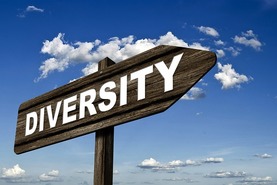
Equality in the workplace takes on the same meaning as it does in your everyday life. It is defined as treating everyone the same, and treating them fairly.
Diversity on the other hand is about treating everyone as an individual and treating them fairly.
Most employers will be well aware of the legal requirement under the equality act (https://www.gov.uk/equality-act-2010-guidance).
However, for many diversity is still a grey area and can even be seen to be a bit frightening!
To employ a diverse workforce is to employ people that are all working to the same vision and mission that Directors and Managers have communicated and yet this workforce is made up of individual people who come from all different backgrounds, have all had different life experiences and very different interests.
How can this work? With a couple of key elements:
Can you imagine seeing an employee doing well - gaining in confidence and skills. It is even more rewarding when it is an employee who hasn't worked for a long time, an employee who says I've been looking for a job for over a year, an employee who you offer flexible working to so they can remain working for you....
Other organisational benefits have been sited as:
Customer care and marketplace competitiveness
Improved Corporate image, brand, ethics and values (Mark & Spencer are a great example)
Recruitment and retention of talent especially the use of word of mouth recruitment, thus lowering costs.)
Increasing creativity and innovation
Being an employer of choice through effective people management and development
Complying with legislation
Corporate social responsibility.
Last night I was fortunate enough to hear Gary Mullholland speak about "The Business Case for Diversity". He has spent several years studying diversity in a wide range of organisations.
In 2008, with some colleagues, he produced a paper on The Business Case for Diversity.
Full details can be found at http://www.academia.edu/171770/Managing_Diversity_and_the_Business_Case.
When Gary asked "Do you work for a diverse organisation" it was surprising to see that although there were many public sector organisations and larger companies represented, none of them raised their hand to indicate a yes. The lone hand came from someone who works in a SME and was backed up with great examples of how diversity really is employed in that organisation.
Are SME's leading the way in diversity? Should we be taking more notes as to how SME's manage their HR function? After all
Diversity on the other hand is about treating everyone as an individual and treating them fairly.
Most employers will be well aware of the legal requirement under the equality act (https://www.gov.uk/equality-act-2010-guidance).
However, for many diversity is still a grey area and can even be seen to be a bit frightening!
To employ a diverse workforce is to employ people that are all working to the same vision and mission that Directors and Managers have communicated and yet this workforce is made up of individual people who come from all different backgrounds, have all had different life experiences and very different interests.
How can this work? With a couple of key elements:
- When recruiting staff they need to be a "fit" for the organisation as opposed to a fit for the job. What is meant by this? Basically it is the similarity of an individual's beliefs and values with the culture, norms, and values of an organisation. What about the job itself? Many other aspects of the role can be matched through training. And if a candidate comes along with the right fit and the right ability then it is a win-win situation.
- The commitment to being open to take on candidates that do not fit into traditional recruitment patterns has to come from the top. There needs to be Director and Senior Management buy-in to make this work.
Can you imagine seeing an employee doing well - gaining in confidence and skills. It is even more rewarding when it is an employee who hasn't worked for a long time, an employee who says I've been looking for a job for over a year, an employee who you offer flexible working to so they can remain working for you....
Other organisational benefits have been sited as:
Customer care and marketplace competitiveness
Improved Corporate image, brand, ethics and values (Mark & Spencer are a great example)
Recruitment and retention of talent especially the use of word of mouth recruitment, thus lowering costs.)
Increasing creativity and innovation
Being an employer of choice through effective people management and development
Complying with legislation
Corporate social responsibility.
Last night I was fortunate enough to hear Gary Mullholland speak about "The Business Case for Diversity". He has spent several years studying diversity in a wide range of organisations.
In 2008, with some colleagues, he produced a paper on The Business Case for Diversity.
Full details can be found at http://www.academia.edu/171770/Managing_Diversity_and_the_Business_Case.
When Gary asked "Do you work for a diverse organisation" it was surprising to see that although there were many public sector organisations and larger companies represented, none of them raised their hand to indicate a yes. The lone hand came from someone who works in a SME and was backed up with great examples of how diversity really is employed in that organisation.
Are SME's leading the way in diversity? Should we be taking more notes as to how SME's manage their HR function? After all
- SMEs make up 99.9% of the total number of businesses in the UK.
- SMEs provide 59.1% of all private sector jobs.
